2009 CHEVROLET HHR window
[x] Cancel search: windowPage 145 of 450

The main components of the instrument panel are the following:
A.Outlet Adjustment on page 3-24.
B.Cruise Control on page 3-10(If Equipped).
C.Turn Signal/Multifunction Lever on page 3-7.
D.Instrument Panel Cluster on page 3-27.
E.Windshield Wipers on page 3-8andWindshield
Washer on page 3-9.
F.Instrument Panel Storage on page 2-51.
G.Traction Control System (TCS) on page 4-10
(If Equipped). Electronic Stability Control (ESC).
SeeElectronic Stability Control (ESC) on page 4-7.
H.Passenger Airbag Status Indicator on page 3-31.
I.Rear Side Cargo Door (HHR Panel Only) on
page 2-12(If Equipped).
J.Hood Release on page 5-13.
K.Driver Information Center (DIC) on page 3-48.
L.Horn on page 3-6.M.Audio Steering Wheel Controls on page 3-94
(If Equipped).
N.Instrument Panel Brightness on page 3-17.
O.Audio System(s) on page 3-61.
P.Climate Control System on page 3-21.
Q.Rear Window Wiper/Washer on page 3-10.
R. Shift Lever (Manual Shown). SeeManual
Transmission Operation on page 2-30andAutomatic
Transmission Operation on page 2-28.
S.Accessory Power Outlet(s) on page 3-19
(If Equipped) and Cigarette Lighter (If Equipped).
SeeAshtray(s) and Cigarette Lighter on page 3-21.
T.Fog Lamps on page 3-16(If Equipped).
U.Hazard Warning Flashers on page 3-6.
V.Glove Box on page 2-51.
3-5
Page 150 of 450
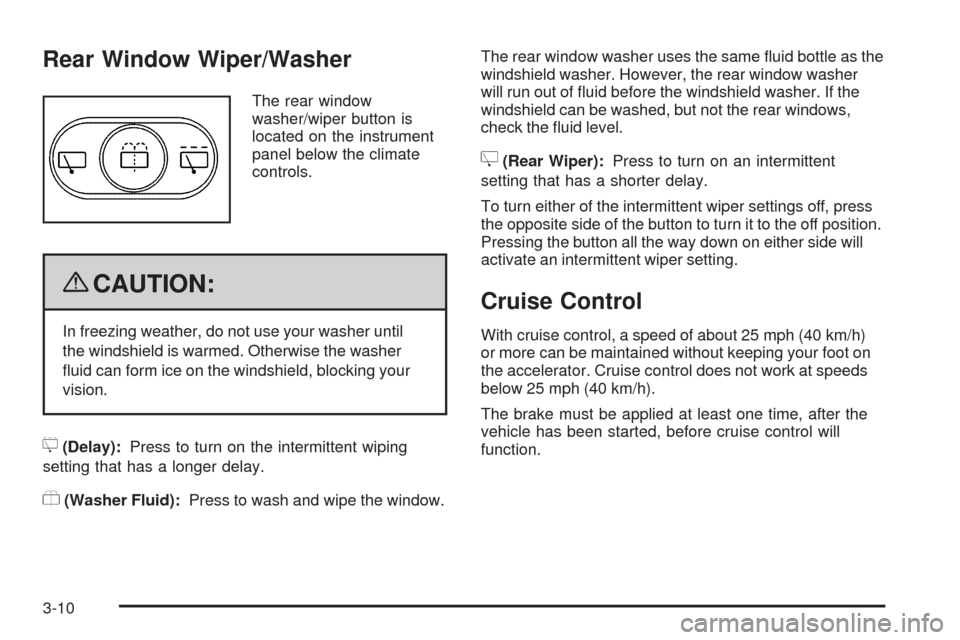
Rear Window Wiper/Washer
The rear window
washer/wiper button is
located on the instrument
panel below the climate
controls.
{CAUTION:
In freezing weather, do not use your washer until
the windshield is warmed. Otherwise the washer
�uid can form ice on the windshield, blocking your
vision.
5(Delay):Press to turn on the intermittent wiping
setting that has a longer delay.
Y(Washer Fluid):Press to wash and wipe the window.The rear window washer uses the same �uid bottle as the
windshield washer. However, the rear window washer
will run out of �uid before the windshield washer. If the
windshield can be washed, but not the rear windows,
check the �uid level.
Z(Rear Wiper):Press to turn on an intermittent
setting that has a shorter delay.
To turn either of the intermittent wiper settings off, press
the opposite side of the button to turn it to the off position.
Pressing the button all the way down on either side will
activate an intermittent wiper setting.
Cruise Control
With cruise control, a speed of about 25 mph (40 km/h)
or more can be maintained without keeping your foot on
the accelerator. Cruise control does not work at speeds
below 25 mph (40 km/h).
The brake must be applied at least one time, after the
vehicle has been started, before cruise control will
function.
3-10
Page 158 of 450
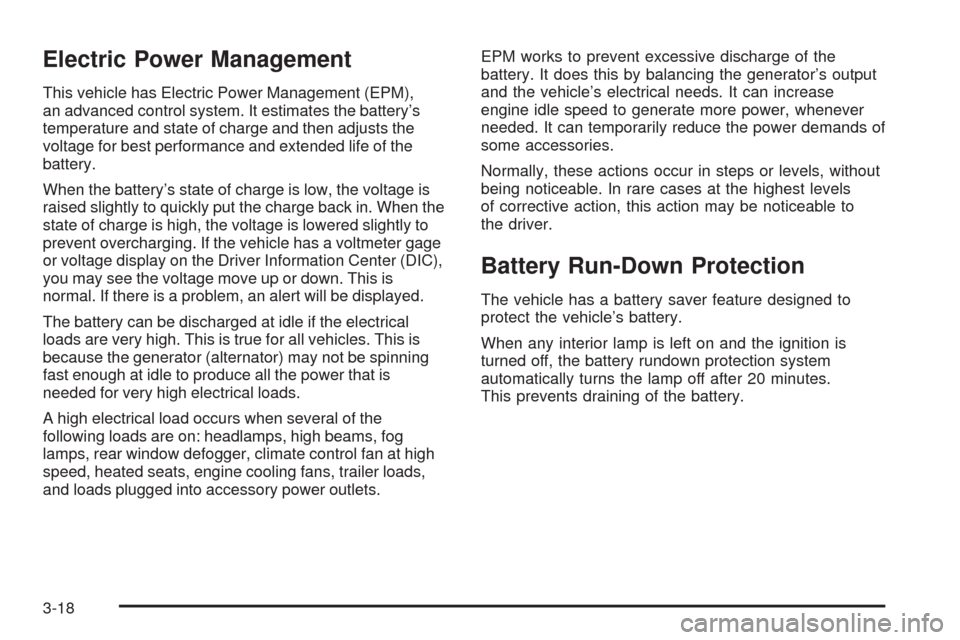
Electric Power Management
This vehicle has Electric Power Management (EPM),
an advanced control system. It estimates the battery’s
temperature and state of charge and then adjusts the
voltage for best performance and extended life of the
battery.
When the battery’s state of charge is low, the voltage is
raised slightly to quickly put the charge back in. When the
state of charge is high, the voltage is lowered slightly to
prevent overcharging. If the vehicle has a voltmeter gage
or voltage display on the Driver Information Center (DIC),
you may see the voltage move up or down. This is
normal. If there is a problem, an alert will be displayed.
The battery can be discharged at idle if the electrical
loads are very high. This is true for all vehicles. This is
because the generator (alternator) may not be spinning
fast enough at idle to produce all the power that is
needed for very high electrical loads.
A high electrical load occurs when several of the
following loads are on: headlamps, high beams, fog
lamps, rear window defogger, climate control fan at high
speed, heated seats, engine cooling fans, trailer loads,
and loads plugged into accessory power outlets.EPM works to prevent excessive discharge of the
battery. It does this by balancing the generator’s output
and the vehicle’s electrical needs. It can increase
engine idle speed to generate more power, whenever
needed. It can temporarily reduce the power demands of
some accessories.
Normally, these actions occur in steps or levels, without
being noticeable. In rare cases at the highest levels
of corrective action, this action may be noticeable to
the driver.
Battery Run-Down Protection
The vehicle has a battery saver feature designed to
protect the vehicle’s battery.
When any interior lamp is left on and the ignition is
turned off, the battery rundown protection system
automatically turns the lamp off after 20 minutes.
This prevents draining of the battery.
3-18
Page 161 of 450
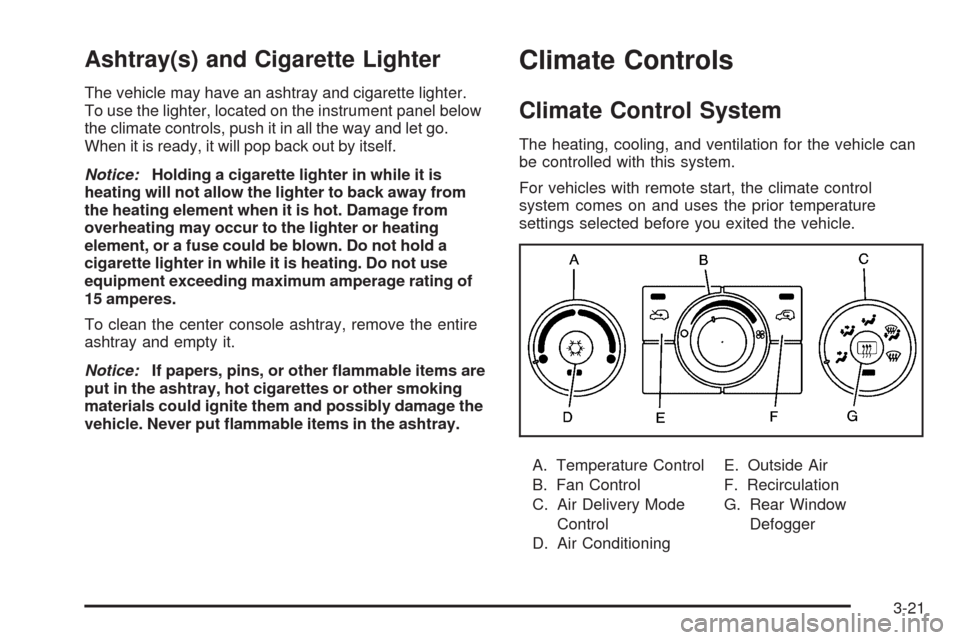
Ashtray(s) and Cigarette Lighter
The vehicle may have an ashtray and cigarette lighter.
To use the lighter, located on the instrument panel below
the climate controls, push it in all the way and let go.
When it is ready, it will pop back out by itself.
Notice:Holding a cigarette lighter in while it is
heating will not allow the lighter to back away from
the heating element when it is hot. Damage from
overheating may occur to the lighter or heating
element, or a fuse could be blown. Do not hold a
cigarette lighter in while it is heating. Do not use
equipment exceeding maximum amperage rating of
15 amperes.
To clean the center console ashtray, remove the entire
ashtray and empty it.
Notice:If papers, pins, or other �ammable items are
put in the ashtray, hot cigarettes or other smoking
materials could ignite them and possibly damage the
vehicle. Never put �ammable items in the ashtray.
Climate Controls
Climate Control System
The heating, cooling, and ventilation for the vehicle can
be controlled with this system.
For vehicles with remote start, the climate control
system comes on and uses the prior temperature
settings selected before you exited the vehicle.
A. Temperature Control
B. Fan Control
C. Air Delivery Mode
Control
D. Air ConditioningE. Outside Air
F. Recirculation
G. Rear Window
Defogger
3-21
Page 162 of 450
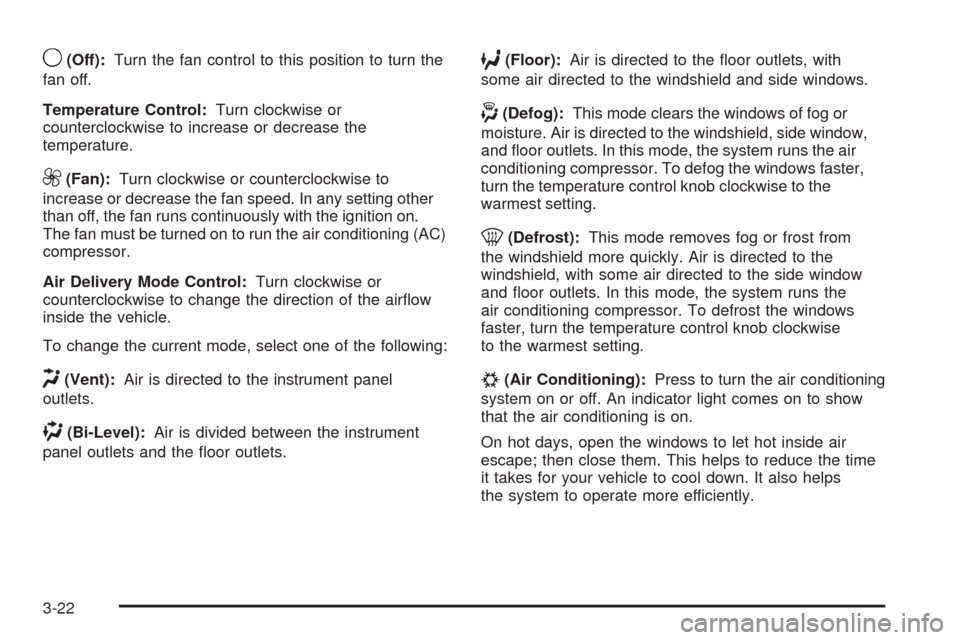
9(Off):Turn the fan control to this position to turn the
fan off.
Temperature Control:Turn clockwise or
counterclockwise to increase or decrease the
temperature.
9(Fan):Turn clockwise or counterclockwise to
increase or decrease the fan speed. In any setting other
than off, the fan runs continuously with the ignition on.
The fan must be turned on to run the air conditioning (AC)
compressor.
Air Delivery Mode Control:Turn clockwise or
counterclockwise to change the direction of the air�ow
inside the vehicle.
To change the current mode, select one of the following:
H(Vent):Air is directed to the instrument panel
outlets.
)(Bi-Level):Air is divided between the instrument
panel outlets and the �oor outlets.
6(Floor):Air is directed to the �oor outlets, with
some air directed to the windshield and side windows.
-(Defog):This mode clears the windows of fog or
moisture. Air is directed to the windshield, side window,
and �oor outlets. In this mode, the system runs the air
conditioning compressor. To defog the windows faster,
turn the temperature control knob clockwise to the
warmest setting.
0(Defrost):This mode removes fog or frost from
the windshield more quickly. Air is directed to the
windshield, with some air directed to the side window
and �oor outlets. In this mode, the system runs the
air conditioning compressor. To defrost the windows
faster, turn the temperature control knob clockwise
to the warmest setting.
#(Air Conditioning):Press to turn the air conditioning
system on or off. An indicator light comes on to show
that the air conditioning is on.
On hot days, open the windows to let hot inside air
escape; then close them. This helps to reduce the time
it takes for your vehicle to cool down. It also helps
the system to operate more efficiently.
3-22
Page 163 of 450
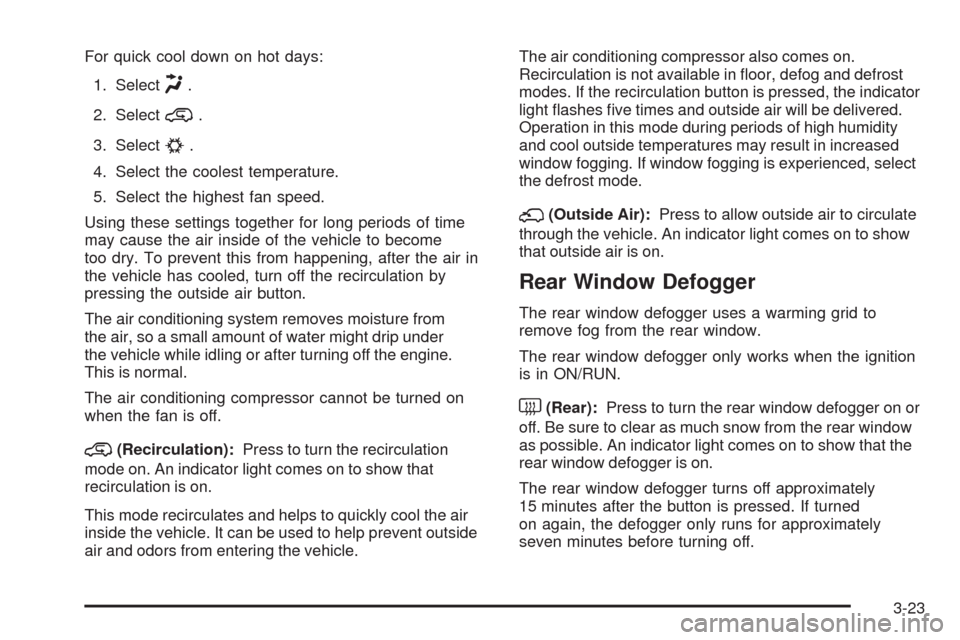
For quick cool down on hot days:
1. Select
H.
2. Select
@.
3. Select
#.
4. Select the coolest temperature.
5. Select the highest fan speed.
Using these settings together for long periods of time
may cause the air inside of the vehicle to become
too dry. To prevent this from happening, after the air in
the vehicle has cooled, turn off the recirculation by
pressing the outside air button.
The air conditioning system removes moisture from
the air, so a small amount of water might drip under
the vehicle while idling or after turning off the engine.
This is normal.
The air conditioning compressor cannot be turned on
when the fan is off.
@(Recirculation):Press to turn the recirculation
mode on. An indicator light comes on to show that
recirculation is on.
This mode recirculates and helps to quickly cool the air
inside the vehicle. It can be used to help prevent outside
air and odors from entering the vehicle.The air conditioning compressor also comes on.
Recirculation is not available in �oor, defog and defrost
modes. If the recirculation button is pressed, the indicator
light �ashes �ve times and outside air will be delivered.
Operation in this mode during periods of high humidity
and cool outside temperatures may result in increased
window fogging. If window fogging is experienced, select
the defrost mode.
;(Outside Air):Press to allow outside air to circulate
through the vehicle. An indicator light comes on to show
that outside air is on.
Rear Window Defogger
The rear window defogger uses a warming grid to
remove fog from the rear window.
The rear window defogger only works when the ignition
is in ON/RUN.
<(Rear):Press to turn the rear window defogger on or
off. Be sure to clear as much snow from the rear window
as possible. An indicator light comes on to show that the
rear window defogger is on.
The rear window defogger turns off approximately
15 minutes after the button is pressed. If turned
on again, the defogger only runs for approximately
seven minutes before turning off.
3-23
Page 164 of 450
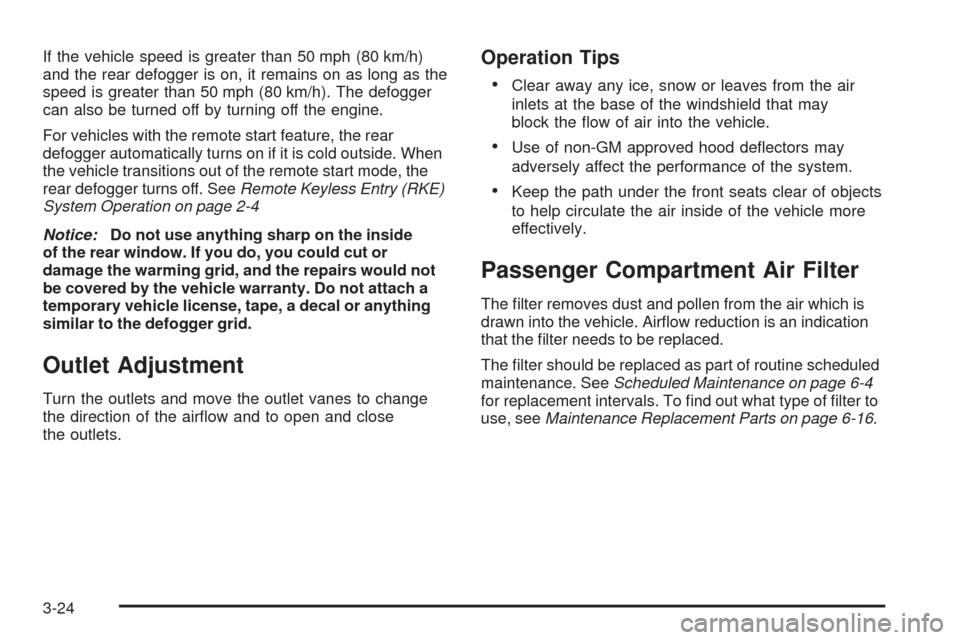
If the vehicle speed is greater than 50 mph (80 km/h)
and the rear defogger is on, it remains on as long as the
speed is greater than 50 mph (80 km/h). The defogger
can also be turned off by turning off the engine.
For vehicles with the remote start feature, the rear
defogger automatically turns on if it is cold outside. When
the vehicle transitions out of the remote start mode, the
rear defogger turns off. SeeRemote Keyless Entry (RKE)
System Operation on page 2-4
Notice:Do not use anything sharp on the inside
of the rear window. If you do, you could cut or
damage the warming grid, and the repairs would not
be covered by the vehicle warranty. Do not attach a
temporary vehicle license, tape, a decal or anything
similar to the defogger grid.
Outlet Adjustment
Turn the outlets and move the outlet vanes to change
the direction of the air�ow and to open and close
the outlets.
Operation Tips
Clear away any ice, snow or leaves from the air
inlets at the base of the windshield that may
block the �ow of air into the vehicle.
Use of non-GM approved hood de�ectors may
adversely affect the performance of the system.
Keep the path under the front seats clear of objects
to help circulate the air inside of the vehicle more
effectively.
Passenger Compartment Air Filter
The �lter removes dust and pollen from the air which is
drawn into the vehicle. Air�ow reduction is an indication
that the �lter needs to be replaced.
The �lter should be replaced as part of routine scheduled
maintenance. SeeScheduled Maintenance on page 6-4
for replacement intervals. To �nd out what type of �lter to
use, seeMaintenance Replacement Parts on page 6-16.
3-24
Page 256 of 450

Before Leaving on a Long Trip
To prepare your vehicle for a long trip, consider having
it serviced by your dealer/retailer before departing.
Things to check on your own include:
Windshield Washer Fluid:Reservoir full? Windows
clean — inside and outside?
Wiper Blades:In good shape?
Fuel, Engine Oil, Other Fluids:All levels checked?
Lamps:Do they all work and are lenses clean?
Tires:Are treads good? Are tires in�ated to
recommended pressure?
Weather and Maps:Safe to travel? Have
up-to-date maps?
Highway Hypnosis
Always be alert and pay attention to your surroundings
while driving. If you become tired or sleepy, �nd a safe
place to park your vehicle and rest.
Other driving tips include:
Keep the vehicle well ventilated.
Keep interior temperature cool.
Keep your eyes moving — scan the road ahead
and to the sides.
Check the rearview mirror and vehicle instruments
often.
4-20